
How To Make Low Flow Measurements Using Turbine Flow Meters
Accurate low flow measurement represents significant challenges in many applications. Some typical low flow applications in the aerospace market include:
- Small UAV fuel consumption
- Satellite thruster fuel consumption
- Fuel/Chemical/Water injection
The low dynamic energy associated with flow rates down to 0.001 GPM exceed the capabilities of most mechanical flow meters and force the use of less accurate flow meter technologies.
The Omniflo® turbine flow meter is designed for the measurement of low flow liquid applications. The Omniflo® incorporates a tangential rotor design for high efficiency and accuracy in low flow applications. The Omniflo® is capable of a minimum flow of 0.001 GPM and a turndown of 80:1.
Performance Specifications:
- Calibration Accuracy: +/-0.05% of reading (accuracy of primary flow calibration standard)
- Repeatability: +/- 0.1% of reading
- Linearity: +/- 0.1% of reading with linearizing electronics
- Dynamic Response: < 5 milliseconds for a step change in flow
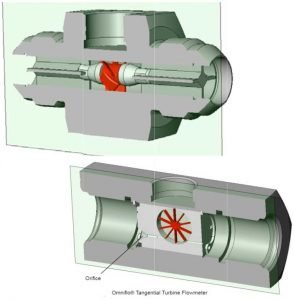
Tangential Design
Unlike an axial turbine flow meter which must convert a flow energy to an axial rotation, the tangentia design utilizes a rotor perpendicular to the flow energy. Additionally, the transfer of flow energy is enhanced in this design through the use of an orifice to direct the flow to the perpendicular rotor blades. This causes the rotor to spin in proportion to the volumetric flow through the flow meter. Sometimes referred to as a Pelton Wheel or Paddle Wheel design, this design is generally considered to be the best solution for efficient conversion of flow energy.
Tangential Design Operation
The Omniflo® Tangential design utilizes a stainless steel housing assembly. A capsule assembly houses the orifice and rotating assembly of the flow meter. The capsule is secured within the housing using retaining rings and grooves in the housing assembly. An O- Ring is utilized on the upstream section of the capsule for use as a seal to insure all flow in the line flows through the capsule assembly for measurement.
Fluid flows through the orifice, impinges on the perpendicular rotor blade and most fluid exits through the downstream orifice. Residual fluid and any air or other gaseous substance existing in the line can escape the flow meter from an opening inn the top of the Omniflo® and a channel machined into the capsule assembly.
Minimum flows down too 0.001 GPM can be accurately measured using this design.
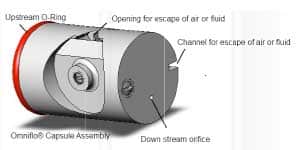
Application Considerations
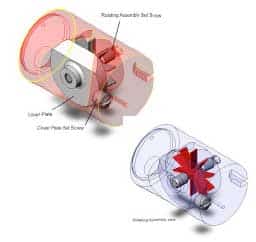
Bearings
The rotating assembly utilized in thee Omniflo® flow meter is designed for maximum efficiency by utilizing low friction bearing components. Depending on the application, there is a choice of 3 different bearing configurations available. In all configurations, the bearing and rotor assemblies are captured using set screws and a cover plate. The cover plate is also retained by a set screw and designed to eliminate rotation.
Sapphire Pivot Bearing
Chosen for its low friction characteristics, the sapphire pivot bearing is the most efficient of the 3 bearing choices. This configuration utilizes a Tungsten Carbide shaft with tapered ends. The rotor is pressed onto the shaft and the shaft rides in a sapphire pivot vee pressed into the set screw assembly. A spring is incorporated into one side of the set screw assembly to maintain a constant force on the shaft.
Benefits
- Can be used in liquid or gas applications
- Can be used in low lubricity applications (water)
- Chemical resistance
- Best efficiency configuration for lowest flow range capability
Cons
- Tungsten Carbide shaft is Can be broken if meter is dropped or subject to high shock loads
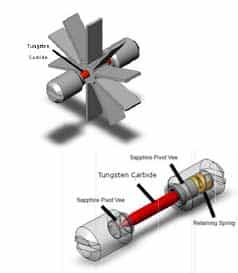
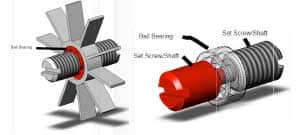
Ball Bearing
Utilized in many turbine flow meter applications, the ball bearing makes for a highly efficient, robust rotating assembly. The ball bearing is pressed into the rotor assembly and rides on a shaft formed from the two set screws.
Benefits
- Good efficiency for low flow range capability
- Robust
Cons
- Recommended for lubricating fluids only
Journal Bearing
The journal bearing configuration is a very robust bearing option for the Omniflo® flow meter. This configuration utilizes a journal (sleeve) which is pressed into the rotor assembly. The journal rides on a shaft captivated by the two set screws.
There are three material choices for the journal bearing material with matching shaft materials chosen for compatibility.
Benefits
- Robust
Cons
- Low efficiency
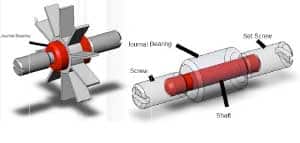
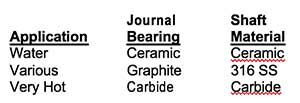
Pickoffs
Either Magnetic or RF pickoffs can be used with the Omniflo® flow meter. For most applications, RF would be the recommendation due to the no drag characteristics of the RF design. When magnetic pickoffs are used, typically to meet sub 185 degrees C temperature requirements, the flow meter turndown will be effective.
Omniflo® Performance
The Omniflo® flow meter is repeatable to +/- 0.1% reading over the normal flow range of the flow meter, with a non-linear output over the entire flow range. This is due to the low kinetic energy of the low flow applications and necessary mechanical conversion of that energy. Although the most efficient designs are applied, friction overcomes the available energy, resulting in a non-linear output.
The non-linear output is not a problem when linearizing electronics or algorithms are used in the down line signal conditioning and/or data acquisition systems. Single or average K-Factor coefficients should not be used due to the non- linear output.
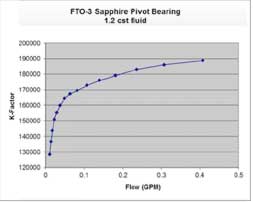
Multi Viscosity Applications
The Omniflo® flow meter can be used with Universal Viscosity Calibration (UVC) data to enable temperature compensation for changing viscosity and changing density if inferred mass output is equired. To utilize the UVC data, a multiple viscosity calibration is performed on the flow meter.
The data is then processed and plotted as the output frequency from the flow meter divided by the kinematic viscosity of the data point on the X axis and the corresponding K-Factor on the Y axis.
As illustrated, this data forms a coincident curve. The data from this curve can be programmed into smart electronics to compensate for the temperature change in viscosity and density during the flow measurement.
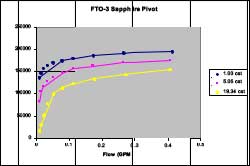
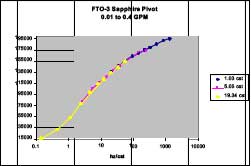
Unlike the very linear 10:1 flow range on an axial turbine flow meter, the Omniflo® flow meter output is non-linear. Due to this non-linearity, care must be taken when using the UVC process. Special attention should be taken in defining the kinematic viscosity of the fluid being measured. The kinematic viscosity of the fluid under test is programmed into the electronics along with a corresponding temperature.
Temperature is measured during operation and a kinematic viscosity derived from the data. The kinematic viscosity data is then divided into the measured frequency from the flow meter to determine the K-Factor used for the volumetric flow rate calculation.
Applications
UAV Fuel Consumption
As UAV’s become smaller and more efficient, accurate fuel consumption data is critical in UAV applications for mission success. The FTO series is capable of measuring down to 0.001 GPM (0.4 PPH), in a compact, robust package for flight applications. Paired with a microLinK pickoff to linearize the calibration curve and compensate for temperature variations, this package will provide an extremely accurate indication of fuel consumed in the UAV. Flow output data can be configured as a frequency, analog (4-20ma or 0-20ma) or CANbus digital.
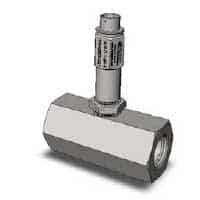
Satellite Thruster Fuel Consumption
The FTO series flow meters can be configured for extreme temperatures that are encountered in space applications. The ball bearing, RF pickoff configuration has an operating temperature range of -185°C to 150°C for maximum flow range ability. Using a magnetic pickoff and ball bearing configuration, the operating temperature range can be expanded to -260°C to 150°C with a more limited flow range due to the use of the magnetic pickoff.
Summary
The Omniflo® turbine flow meter is designed for low flow liquid or gas applications and can be configured in many different ways to meet the needs of many low flow applications in the aerospace industry. Utilizing the new microLinK smart pickoff, a very compact, lightweight, temperature compensating low flow measurement solution is available. With proper configuration selections to meet the application, a highly effective robust low flow measurement can be accomplished. For more information, visit: www.ftimeters.com









